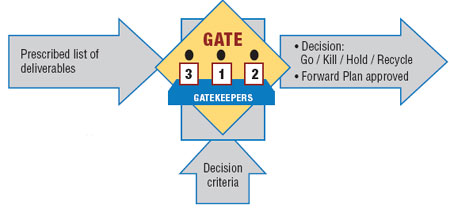Ashraf Ali understands the importance of giving his company’s gatekeepers some serious armaments so they can have the power to decide whether to kill or let go.
The president of Markham, Ont.-based Fastek International Inc. is — much like many Canadian small businesses — feeling the pain of the current recession. Business for the technology integration company is down, but not over, and Ali is looking for surefire ways to know the new projects he invests in are likely to offer a return. Having a tough-as-nails gatekeeper is one way to do that.
“The gatekeeper doesn’t let you go to the next gate until you’ve completed the activities of the current stage,” he explains. “This will allow you to kill projects really soon. Rather than take a long time to make mistakes, you make them quickly and then learn from them.”
The process model for research and development decision-making in a business is one evangelized by Stage-Gate International. Ali heard about the model at a seminar at the Innovation and Synergy Centre in Markham, and now plans to apply it to his own business.

With few resources and even less room for error in a down economy, the process will prevent his company from chasing ideas that will never bring value.
“If we get a bright idea, we usually think we should do it and we just go by our gut feel instead of doing due diligence,” Ali says. “That’s not a good idea.”
Gates are not to be mistaken for a mere project status meeting, or a milestone check, according to Stage-Gate. Instead, they are quality control check-points that weed out the projects that will not provide solid returns, and commit enough resources to projects that should move forward.
Senior management should be involved as gatekeepers, writes Robert Cooper, the inventor of the Stage-Gate process, in a white paper. They need to come to the gatekeeping sessions prepared to either kill a project, or commit resources that are needed. A common mistake is for companies to put in place toothless gatekeepers that don’t have bite.
“The result is that projects are rarely killed at gates,” Cooper writes. “Instead of the well-defined funnel that is so often used to define the new product process, one ends up with a tunnel where everything that enters comes out the other end, good projects and bad.”
Ali has witnessed this first-hand at an old company where we worked. The process broke down and workers were just filling in the blanks to get their projects approved.
“They basically provided any answers and the gate would be opened,” he says.
The Stage-Gate process was designed with the product creation cycle in mind. But it has since been applied to business process management as well.
Small businesses may be able to use a gatekeeper approach to help guide them through the current economic climate, says Paul Edwards, the director of SMB & channels research at IDC Canada. For example, a firm may want to do more business with current clients instead of spending money to woo new ones. So the gate process can be used to consider a new partnership.
“If you’re thinking about a partner strategy, the first question is to ask is if your business objective is well-defined,” Edwards says. “It’s important to formalize this as much as possible. But not to the point of it being too cumbersome, just to the point that you’re able to list all of the requirements and decisions going to be made.”
Getting bogged down with too much bureaucracy and paperwork concerns Ali. He feels having a small company gives him an advantage to respond quickly to new opportunities and he doesn’t want to lose out on that.
“The flip side of this is you can’t spend too much time mulling over a project, or you’ll never get anything started. It’s a fine balance,” he says. “It can become a bottleneck problem.”
One way to avoid that is to have a small group of workers who aren’t constrained by the process, he adds. Allowing about 10 to 15 per cent of the staff to be creative and try out whatever they need to come up with new products might be a good idea.
Companies should be using objective scorecards with a pre-determined rating system that gatekeepers fill out at these sessions, Cooper writes. Also, by requiring that resource commitments are made at the sessions, some projects will have to be cut just because there won’t be enough resources to handle everything.
“Approval decisions are rather meaningless unless a cheque is cut,” he writes. “The project leader and team must leave the gate meeting with the resources they need to progress their project.”
Ali will be seeking some external funding from the government to help him cover those investment cheques. He plans to request funding from the National Research Council of Canada’s Industrial Research Assistance program.
The fund promises to cover projects up to $50,000 with a quick turnaround for approvals, he says. It covers the payroll costs of research projects.




